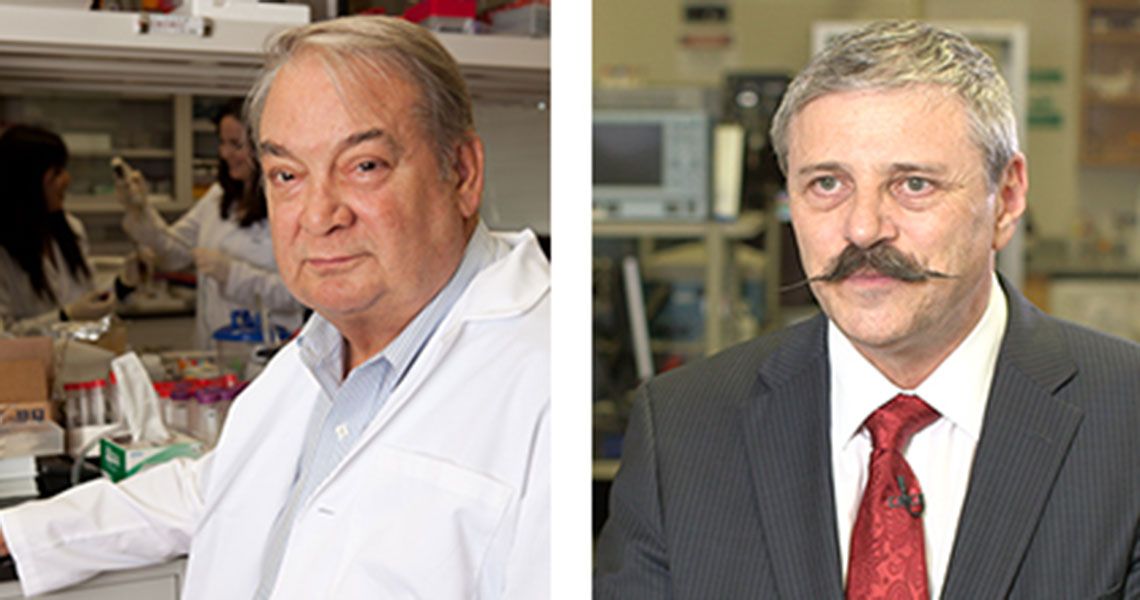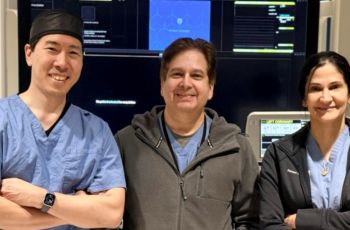Ferid Murad and Akos Vertes—two of George Washington University’s scientific pioneers—are among the 143 innovators who have been named 2013 Fellows of the National Academy of Inventors.
The distinction is awarded to academics who have created or facilitated outstanding inventions that have made an impact on quality of life, economic development and the welfare of society. This year’s NAI Fellows represent 94 universities and research institutes. Nominated by their peers, they hold a combined total of more than 5,600 U.S. patents.
Nobel Laureate Dr. Murad, who leads a lab program in the School of Medicine and Health Sciences’ Department of Biochemistry and Molecular Medicine, has made groundbreaking discoveries of the biological effects of nitric oxide. Dr. Vertes, a professor of chemistry in the Columbian College of Arts and Sciences and the founder of GW’s W. M. Keck Institute for Proteomics Technology and Application, recently created an ambient ionization method that enables the direct analysis of cells and tissues.
Dr. Murad and two other researchers received the Nobel Prize in Medicine in 1998 for their discovery of the role of nitric oxide in the cardiovascular system. This discovery uncovered a new mechanism for how blood vessels in the body relax and widen. Dr. Murad’s work has contributed to a better understanding of how information is transmitted between cells, which has helped doctors understand a range of medical conditions.
Dr. Murad joined the GW faculty in April 2011 and holds the title of University Professor, the university’s highest academic rank. In addition to establishing various research endeavors at GW, he teaches the undergraduate course, “Science and Medicine: A Priceless Journey.”
“This is a very pleasant honor coming from the scientific community for my original important discovery,” Dr. Murad said regarding his election in the NAI Fellows. “With more than 130,000 research publications today, the nitric oxide field has affected most areas of medicine and biology with numerous novel therapies in discovery research or clinical trials for a variety of diseases.”
Dr. Vertes and his team at GW developed the Laser Ablation Electrospray Ionization (LAESI), technique, allowing the researchers to more quickly and effectively learn the chemical composition of a biological sample. The technique was licensed to Protea Biosciences Inc., which developed the commercial product— the LAESI-DP 1000 Direct Ionization System—last year. The invention was the recipient of a 2012 R&D 100 Award, ranking it as one of the 100 most technologically significant products introduced in the past year.
“One of the major objectives in analytical chemistry and in the biological sciences is to understand the composition of tissues and individual cells,” Dr. Vertes said. “The major breakthrough in the LAESI technology is that is enables us to target an individual cell for analysis using mass spectrometry, which means that we can find the metabolic composition of a live cell.”
Dr. Vertes said he is honored to be among “powerhouses” of chemistry, such as Harvard University’s George M. Whitesides, who was also awarded the NAI distinction this year.
The NAI Fellows will be inducted by Deputy U.S. Commissioner for Patents Andy Faile during the 3rd Annual Conference of the National Academy of Inventors on March 7 in Alexandria, Va.



